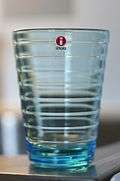Aino Aalto
Aino Maria Marsio-Aalto (born Aino Maria Mandelin;[1] 25 January 1894 – 13 January 1949) was a Finnish architect and a pioneer of Scandinavian design. She is known as a co-founder of the design company Artek and as a collaborator on its most well-known designs.[2] As Artek's first artistic director, her creative output spanned textiles, lamps, glassware, and buildings.[3]
Aino Aalto | |
|---|---|
 | |
| Born | Aino Maria Mandelin 25 January 1894 |
| Died | 13 January 1949 (aged 54) Helsinki, Finland |
| Nationality | Finnish |
| Alma mater | Helsingin Suomalainen Tyttökoulu Helsinki University of Technology |
| Occupation | Architect, designer |
| Spouse(s) | Alvar Aalto (m. 1925–49; her death) |
| Children | 2 |
| Practice | co-founder of Artek |
Biography
Aino Mandelin was born in Helsinki, and completed her school education in 1913 at the Helsingin Suomalainen Tyttökoulu (Helsinki Finnish Girls' School). She began studies in architecture that same year at the Institute of Technology, Helsinki, and qualified as an architect in 1920. That same year she went to work for architect Oiva Kallio in Helsinki. In 1923 she moved to the city of Jyväskylä to work in the office of architect Gunnar Achilles Wahlroos, but the following year switched to working in the office of architect Alvar Aalto. Mandelin married Alvar Aalto in 1925. The Aaltos spent their honeymoon in northern Italy. It was common at that time for young architects in Scandinavia to travel to Italy to study the vernacular architecture, which had a profound influence on Scandinavian architecture during the 1920s, flourishing in the so-called Nordic Classicism style.
The Aaltos moved their office to Turku in 1927, and started collaborating with architect Erik Bryggman. The office moved again in 1933 to Helsinki. The Aaltos designed and built a joint house-office (1935–36) for themselves in Munkkiniemi, a suburb of Helsinki, but later (1954–55) had a purpose-built office built in the same neighbourhood.
Aino Aalto's role in the design of the architecture attributed to Alvar Aalto has never been specifically verified. Their early built works were mostly small-scale buildings, especially summer villas, designed in the style of Nordic Classicism. Chief among these was the Aalto's own summer villa, Villa Flora in Alajärvi from 1926 (extended 1938).
It is known that in the design work she concentrated more on the design of interiors (such as the world-famous Villa Mairea in Noormarkku of 1937-39), but also furniture (such as the Paimio Sanatorium of 1927–29). In 1935 the Aaltos, together with Maire Gullichsen (chief client for the Villa Mairea) and Nils-Gustav Hahlin, founded Artek, a firm selling lighting fixtures and furniture designed by the Aaltos. Aino was the head designer of Artek and later became the managing director of the firm.[4] Artek still produces Aalto furniture today, but now it is owned by a private company.[4] In the early years of their marriage and design partnership Aino Aalto and her husband would enter architectural competitions with their own separate entries. In the mid 1920s the Aaltos became the first architects in Finland to adopt the purified Functionalist style of architecture coming from central Europe. In Aino Aalto's own individual work this comes out in her entry for the Finnish pavilion for the 1939 New York World's Fair, the first prize for which, however, was won by Alvar Aalto.

Aino Aalto also designed several glassware objects for the Finnish company Iittala, who made household objects. Her most famous glass design is still on sale, and slightly different copies made by companies such as IKEA are widespread. She also collaborated with her husband on the design of the celebrated Savoy Vase in 1936.
Aalto actively worked in the Artek office until 1949, when she died of cancer.
In 2004 an exhibition and book (edited by Ulla Kinnunen) was arranged at the Alvar Aalto Museum, Jyväskylä, Finland, featuring the life's work of Aino Aalto.
Notes and Citations
- From 1906 onwards the family was known as Marsio
- Jari Jetsonen; Jetsonen Sirkkaliisa (20 March 2008). Finnish Summer Houses. Princeton Architectural Press. pp. 48–. ISBN 978-1-56898-752-1.
- Lucy Ryder, Richardson (8 December 2016). 102 Midcentury Chairs: and their stories. Pavilion Books. pp. 91–. ISBN 978-1-911216-80-3.
- Lee, Vinny (2012-09-01). "The house that Alvar Aalto built". The Times. ISSN 0140-0460. Retrieved 2018-03-22.
References
- Helamaa, Erkki & Jetsonen, Jari: Alvar Aalto Summer Houses. Rakennustieto, Helsinki, 2007.
- Kinnunen, Ulla (ed.): Aino Aalto. Alvar Aalto Museum, Jyväskylä, 2004.
- Suominen-Kokkonen, Renja: Aino and Alvar Aalto. A shared journey: Interpretations of an everyday modernism. Jyväskylä, Alvar Aalto Museum, 2007.
External links
| Wikimedia Commons has media related to Aino Aalto. |
- Aino Aalto collection at the Israel Museum. Retrieved September 2016.